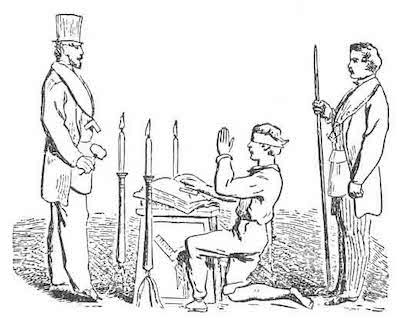Freemasonry has
three tiers ("degrees") of membership: Entered Apprentice,
Fellowcraft, and Master Mason. Bloom seems to be speaking from
the second of these levels, "
fellowcraft," and
addressing the constable, "
worshipful master," as his
superior. In addition to indicating an initiate's progress in
the symbolilc mysteries of the order, "Master" is the title of
the highest-ranking official in a local organization, the Master
of the Lodge. In many lodges this officer is addressed as
Worshipful Master.
The "
square" is one of the two primary symbols of
Freemasonry, along with the compass, and it figures in many
masonic rituals. The image shown here of a man being raised to
the degree of Fellowcraft, for example, has the accompanying
text: "Kneeling on my naked right knee, my left forming a
square; my right hand on the Holy Bible, square, and compasses,
my left arm forming an angle, supported by the square, and my
hand in a vertical position." Bloom makes a slightly different
kind of square when he "
gives the sign and dueguard of
fellowcraft." Sign and due guard are masonic terms
for bodily gestures signifying that the member will faithfully
perform and
duly guard the mysteries of the order. One
of these involves a square. In the other, the member
acknowledges that he is subject to penalties if he divulges the
order's secrets, by drawing a hand violently across his chest or
throat.
Slote quotes from Avery Allyn's
A Ritual of Freemasonry
(1831) a formula for these two actions that is remarkably close
to Bloom's: "The sign is given by taking hold of the left
breast, with the right hand, as though you intended to tear a
piece out of it, then draw your hand with the fingers partly
clenched, from the left to the right side, with some quickness,
and dropping it down to your side. The due-guard is given by
raising the left arm until that part of it between the elbow and
shoulder is perfectly horizontal; and raising the rest of the
arm in a vertical position, so that part of the arm below the
elbow, and that part above it forms a square. This is the
due-guard. The two are always given together by Masons, and are
called
the sign and due-guard of a fellow craft: they
would not be recognized by a Mason, if given separately." Both
Gifford and Slote note that in performing these actions Bloom is
giving one of a Freemason's "signs of distress," asking fellow
members for assistance and protection.
In context, then, Bloom seems to be appealing to the constable
as a fellow Mason and asking for his assistance––a fantastical
and pathetically ineffective plea. The Freemasons are a
non-sectarian order who admit members from different faiths, but
in Ireland in 1904 their members came mostly from the
Anglo-Irish ruling class and the Catholic church viewed them as
a Protestant (and, to a degree, Jewish) organization that was
more dangerous than atheism. Gifford correctly observes that "in
all probability the constables of the Dublin Metropolitan Police
would be 'good Catholics', suspicious and fearful of Freemasonry
as some ultimate force of atheism and subversion."
Drawing on several sources, Slote observes that Bloom's
declaration to the constable, "light of love," had a
clear Masonic meaning in 1904, having been "proverbial in
Dublin lodges since the eighteenth century." It expressed the
belief that Freemasonry "carried always the light of love and
universal tolerance to all Mankind." But this phrase also is a name
for sexual licentiousness in Shakespeare's Much Ado––a
fact which threatens to undercut Bloom's claim to be guiltless
of the charges laid against him by Martha Clifford.
Additionally working to undermine his plea is the fact that
both "worship" and "master" are sycophantish terms of address
regularly used in that play by Dogberry, a moronic constable.
In an amazing feat of verbal dexterity, Joyce manages to make
both halves of this sentence ("No, no, worshipful master,
light of love") simultaneously proclaim masonic purity and
confess sexual immorality. The effect is reminiscent of
Dogberry, who regularly manages to say the opposite of what he
means.

